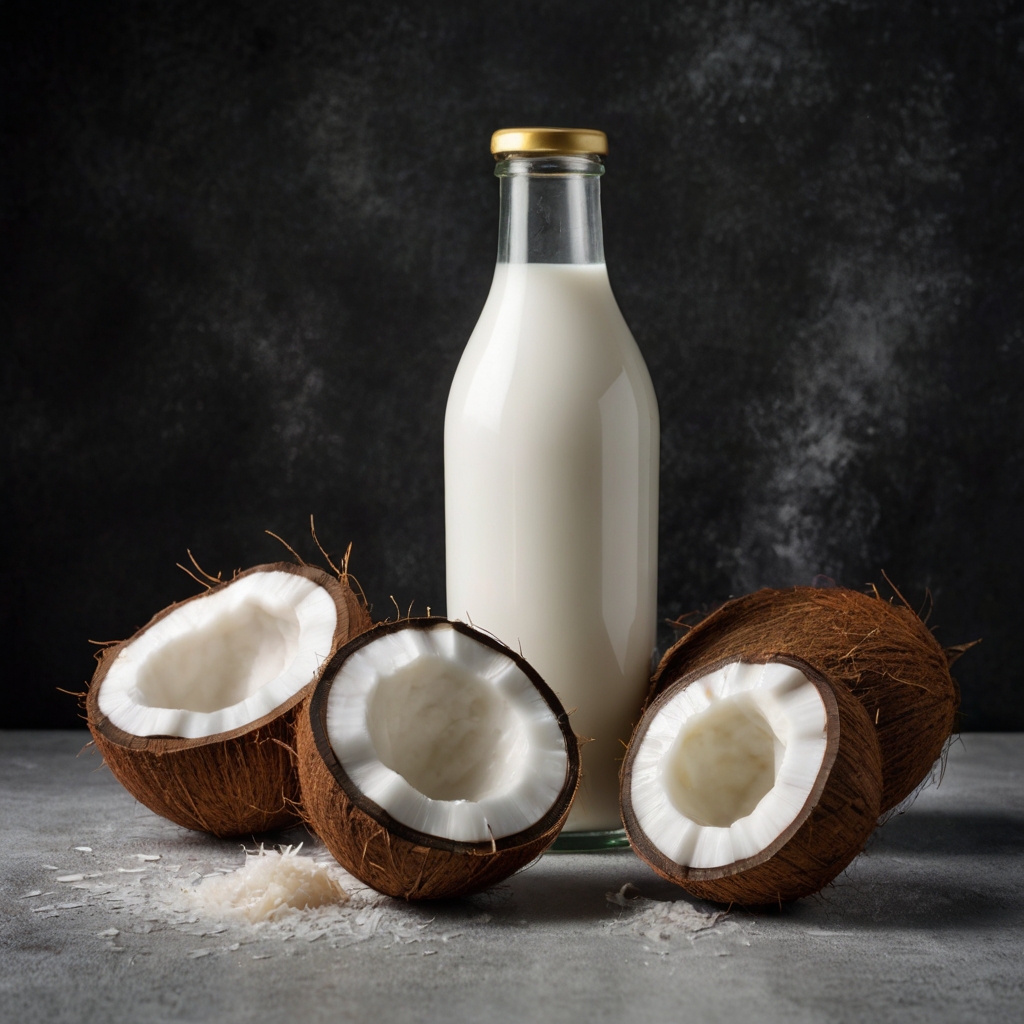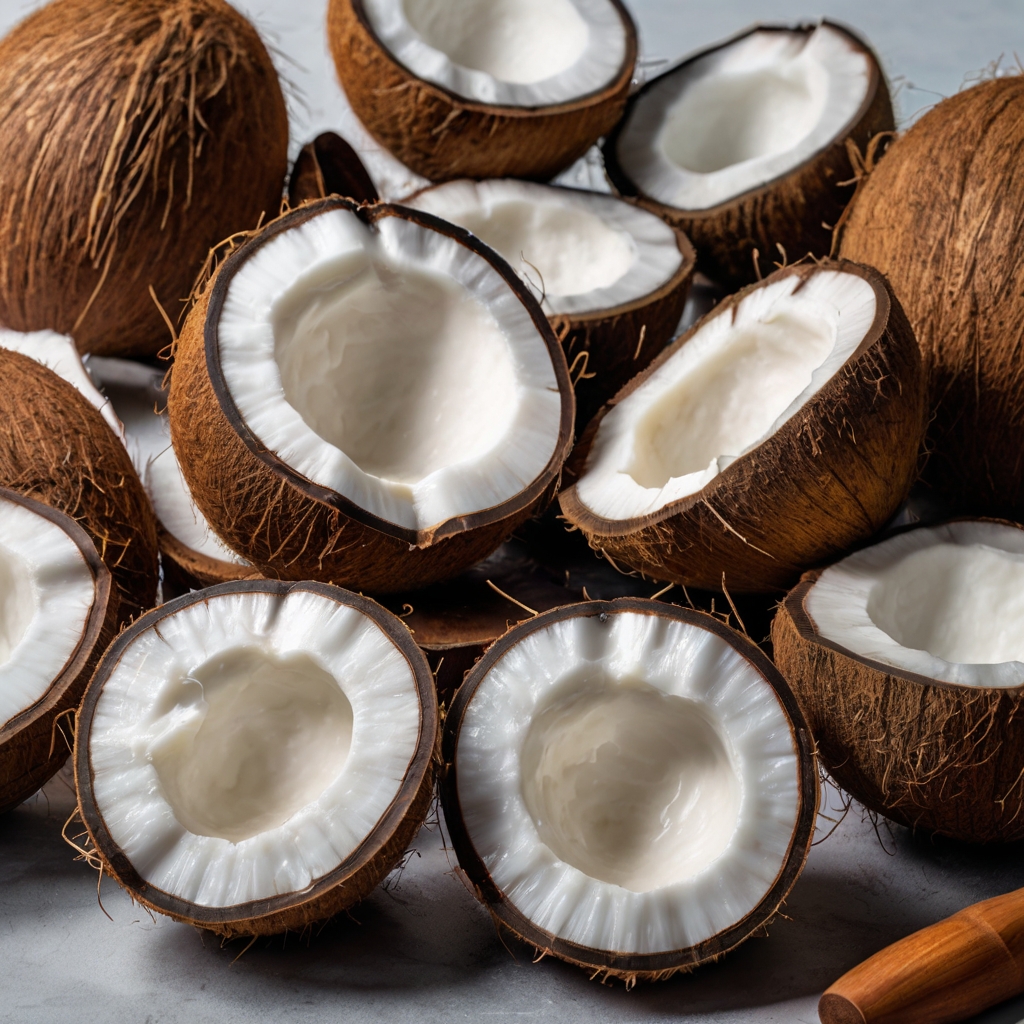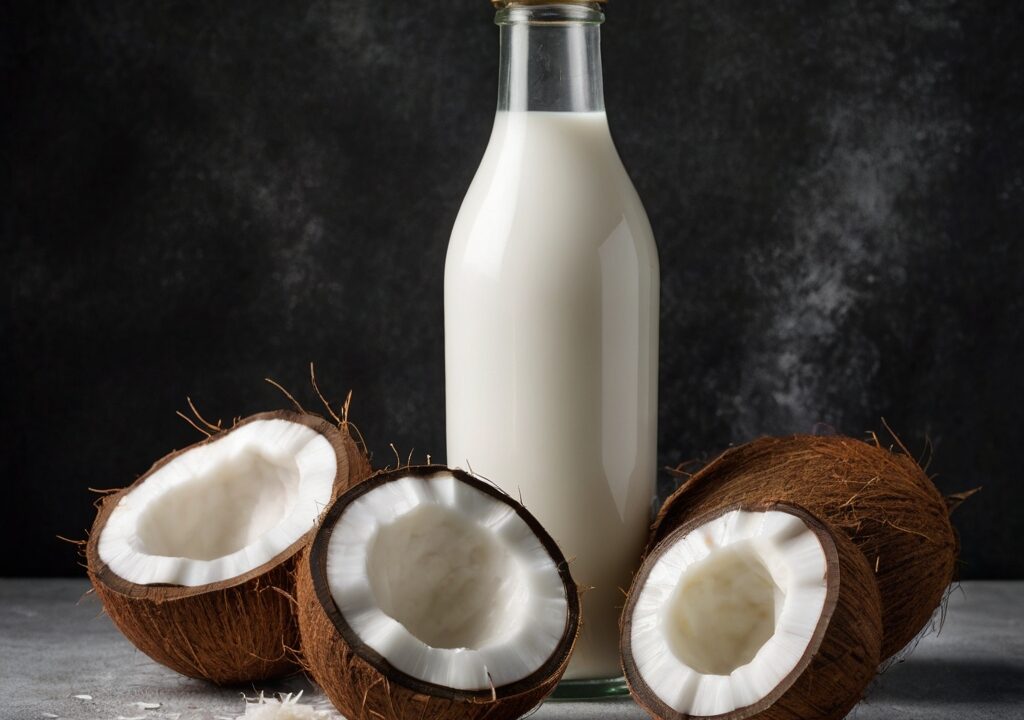How Long Does Coconut Milk Last in the Fridge
Many home cooks wonder about coconut milk’s shelf life in the fridge, especially after using just part of it for curry or dessert. A sealed, unopened container stays fresh for months. Some cans remain good for 2 to 5 years when stored properly.
The story changes once you open the container. Coconut milk lasts much less time after opening – about 4 to 10 days in the fridge. Fresh coconut milk made at home stays good up to five days when kept in an airtight container in the refrigerator. The best way to keep leftover coconut milk fresh is to move it from the original can into a sealed jar or container.
Nobody likes to find curdled or sour coconut milk hiding in their fridge. You can easily tell if it’s gone bad – just throw it away if you see curdling or notice a sour smell. In this piece, you’ll learn the right storage methods and freezing techniques to make your coconut milk last longer.

How long does coconut milk last in the fridge after opening?
The clock starts ticking as soon as you open your coconut milk can or carton. Your opened coconut milk will stay fresh between 4 to 10 days in the refrigerator. All the same, several factors like packaging type, fat content, and storage methods affect this timeframe.
Canned vs. carton shelf life after opening
Canned and carton coconut milk differ in how long they last after opening. Your canned coconut milk stays fresh for 5 to 7 days in the refrigerator. Some people find it lasts up to 10 days in an airtight container.
Carton coconut milk from the refrigerated section stays fresh longer – about 7 to 10 days after opening. This happens because manufacturers process canned and carton varieties differently. Canned coconut milk stays shelf-stable without additives or preservatives, while carton coconut milk goes through higher temperature pasteurization.
The difference becomes more obvious before opening. An unopened can lasts 2 to 5 years at room temperature. Carton coconut milk stays good for 6 to 12 months before opening.
How long does full-fat coconut milk last?
Full-fat coconut milk outlasts its lower-fat versions. The milk’s thick, rich consistency helps it stay fresh longer. You can keep thick coconut milk fresh for about 7 to 10 days in your refrigerator.
The high fat content helps preserve the milk by slowing down bacterial growth. A glass jar or airtight container works better than the original can for storage after opening.
Most chefs notice spoilage signs around week one. Pink mold often appears around the milk’s edges after a week of storage.
Why refrigeration is essential
Your opened coconut milk needs refrigeration. Room temperature storage increases spoilage risk and bacterial contamination. Warm temperatures make coconut milk separate and develop off-flavors and textures.
Cold temperatures slow down the bacteria that spoil food. Keep your coconut milk at 40°F or below. Put it in the fridge right after opening – it should never sit out.
Unrefrigerated coconut milk can harbor dangerous bacteria like salmonella, listeria, and E. coli. These bacteria grow faster at room temperature, which makes proper refrigeration vital for food safety.
An airtight container helps your coconut milk last longer than keeping it in the opened can. This step maintains quality and keeps other food smells away from your milk.

How to store opened coconut milk properly
You can extend your opened coconut milk’s life with proper storage. The right techniques will save you from finding a spoiled half-used can days later.
Use airtight containers or glass jars
Your coconut milk needs an airtight container to stay fresh. Glass Mason jars or plastic containers with tight seals work best to keep the quality. Glass bottles give you an extra benefit – you can shake them easily to mix the fat particles throughout the liquid.
Coconut milk stays fresh for about 5-7 days when stored in an airtight container. Some say it might last up to a week. This depends on how you store it and how fresh it was to begin with.
Glass containers won’t react with your coconut milk or change its taste, unlike metal cans. You might want to split your coconut milk into smaller containers if you use just a little at a time.
Avoid storing in the original can
Never leave coconut milk in its opened can. The USDA says you should move leftovers to an airtight glass or plastic container instead of just covering the can with plastic wrap.
The flavor takes a hit when you leave coconut milk in its opened can. The Kitchn points out that it could pick up a metallic taste. Modern canning has improved, but there used to be worries about BPA leaching from can liners into food, especially acidic items.
Moving your leftover coconut milk to a clean container helps keep its flavor and quality at their best. Epicurious notes that many modern cans don’t have BPA, but food experts still recommend transferring the contents.
Label with date of opening
Put the opening date on your container – this vital step will help track storage time. You won’t have to guess how long it’s been in the fridge, and you’ll waste less food.
Canned coconut milk lasts 5-7 days after opening, while carton varieties go for 7-10 days. Dating your container lets you know exactly when to use it up.
Temperature changes and air exposure can affect how long your coconut milk stays good. Keep your labeled container in the coldest part of your fridge – usually toward the back.
Fresh cans often show separation between coconut cream and water. Try blending these parts for 1-2 minutes before storage until they look like heavy cream. This step keeps the texture consistent and ready to use in recipes.
Always grab clean utensils when you handle stored coconut milk. This simple habit, plus good containers and clear labels, will keep your coconut milk fresh and tasty until you need it in your next dish.
How to tell if coconut milk is bad
Spotting bad coconut milk isn’t hard if you know what to look for. Your leftover full-fat coconut milk in the fridge or that old can in your pantry might need a quick check before use. Let me show you the signs that could save you from ruining your dish.
Color changes to watch for
Fresh coconut milk should be bright white. The color starts to fade as it goes bad. Once opened, the milk gets darker – a sure sign it’s past its prime. A grayish or yellowish color means oxidation has affected both taste and safety.
Looking at the color is the quickest way to check. Throw it out if it looks darker, even if it hasn’t expired yet. Store-bought varieties with additives might not show such obvious changes but still need checking.
Unpleasant or sour smell
Your nose is the best tool to tell if coconut milk has gone bad. Fresh coconut milk has a light, sweet smell that reminds you of the tropics. Bad coconut milk tells a different story.
The smell turns sour or musty when it spoils. Nature’s warning system works great here – any smell that’s not mildly coconutty means it’s time to toss it. Most chefs call this the sniff test. If something smells wrong, don’t take chances with your recipe.
Texture issues: curdling or separation
Texture changes need a closer look. Don’t worry about normal separation where cream floats to the top. This happens a lot in cold coconut milk and fixes itself with gentle heat and stirring.
Stubborn lumps that won’t mix after shaking are different. Good brands might look a bit grainy after sitting still. But if it stays chunky despite hard shaking, it’s probably spoiled. Bad texture looks gritty or curdles like cottage cheese.
Coconut milk naturally separates below 57.2°F or above 176°F. Separation in your fridge is normal and fixes with warming and mixing. Graininess that won’t go away means bacteria have started breaking it down.
Mold or bubbling signs
Mold gives you a clear sign something’s wrong. Look for odd colors, fuzzy spots, or strange films on the surface. The container’s edges often show mold first. Some people see pink mold around the edges after about a week in the fridge.
Check canned coconut milk’s lid carefully. Mold there means the whole can is bad. Bubbling or fermentation also shows bacterial growth – time to throw it out.
If looks, smell, and feel leave you unsure, try a tiny taste. Bad coconut milk tastes sour or off, nothing like its normal mild sweetness.
Trust your gut when it comes to coconut milk safety. Even slightly spoiled milk can mess up your whole dish and make you feel sick. Tasting as you cook helps catch problems before they ruin your food.
Freezing coconut milk: pros and cons
Freezing unused coconut milk is a great way to save this versatile ingredient that doesn’t last long in your fridge. You’ve probably found yourself with opened or unopened cans sitting there until they go bad. The good news? You can keep coconut milk fresh for months by freezing it properly.
How freezing affects texture and flavor
The texture changes quite a bit at the time coconut milk freezes. The emulsion breaks down and fat solids separate from liquids, which leaves you with a grainy texture after thawing. This happens because coconut milk, just like cow’s milk, blends oils with water.
The flavor stays mostly the same even with these texture changes. That’s why frozen and thawed coconut milk works great in recipes where texture isn’t a vital part—smoothies, baked treats, or simmered curries all work well.
Most manufacturers tell you not to freeze coconut milk. Professional chefs agree and suggest using thawed coconut milk to cook rather than drink it straight.
Best practices for freezing in cubes or bags
Here are the quickest ways to store your coconut milk:
- Ice cube trays: These work great for small portions (about 2 tablespoons per cube). Just pop the frozen cubes into freezer bags for easy use later.
- Freezer bags: Freeze them flat to make thin sheets that thaw quickly. Push out all the air before sealing to stop freezer burn.
- Small containers: Perfect for storing recipe-sized portions – just leave some room for expansion.
Your coconut milk will last much longer in the freezer—instead of one week in the fridge, it stays good for 1-2 months or up to 6 months. Remember to move the coconut milk into freezer-safe containers first – never freeze it in the original metal can.
How to re-emulsify after thawing
Re-emulsifying is a must after thawing frozen coconut milk. This step turns that separated, curdled-looking mix back into something you can use.
Let the coconut milk thaw completely in your fridge, which usually takes a full day. You could use warm water baths or microwave defrost settings to speed things up, but slow thawing gives better results.
After thawing, blend everything back together. An immersion blender does the job perfectly—30 seconds usually makes it smooth again. A regular blender or some energetic whisking works too. Without this blending step, you’ll end up with coconut water and floating fat chunks.
Smart freezing techniques give you more options with this perishable ingredient. You’ll waste less and save money while cooking your favorite recipes.
Canned vs. carton coconut milk: storage and usage differences
Canned and carton coconut milk are different in many ways beyond their packaging. These differences shape how you store and use them in cooking, and each type works better for specific uses.
Shelf life comparison
These two products last very differently on your shelf. An unopened can of coconut milk stays good for 2-5 years at room temperature, but carton coconut milk only lasts 6-12 months before opening. Both need to go in the fridge after opening. Your canned coconut milk stays fresh for 7-10 days, while the carton version keeps for about a week.
The coconut milk you buy from grocery store coolers needs constant refrigeration and should be used by its expiration date. Shelf-stable carton packaging keeps coconut milk fresh without refrigeration for about six months when unopened. This method preserves its nutrients without needing extra preservatives.
Best uses for each type
Canned coconut milk works great in recipes that need thick texture and strong coconut flavor. The high fat content and thick consistency make it perfect for curries, puddings, and creamy sauces. Coconut, not water, usually tops the ingredient list. This shows how concentrated it is.
Carton coconut milk serves as a better substitute for dairy milk. You’ll find its thinner consistency and lighter flavor perfect for smoothies, coffee, cereal, and baking when you want just a hint of coconut. Most chefs say you shouldn’t swap carton milk in recipes that ask for canned coconut milk because your dish won’t be rich enough.
Additives and stabilizers impact
The ingredients in these products tell different stories. Canned coconut milk keeps things simple – we mostly see coconut and water, with some guar gum to keep it stable. This helps keep its real coconut taste.
Carton coconut milk has more ingredients added to it. You’ll find thickeners (guar gum, xanthan gum, carrageenan), vitamins, minerals, salt, and sometimes sugar. These additions help make it feel more like dairy milk. Some brands add antioxidants like sodium metabisulphite to stop browning and make it last longer.
The stabilizers in carton coconut milk keep it from separating, while canned varieties might split into cream and liquid layers in your fridge.
In a few words
Now that you’re learning about coconut milk storage, you have the knowledge to make this versatile ingredient last longer in your kitchen. Without doubt, proper storage extends coconut milk’s usability by a lot, whether you prefer the rich, creamy canned variety or the lighter carton alternative.
Refrigeration is crucial once you open any coconut milk product. Your leftover coconut milk should go into airtight glass containers instead of the original can to prevent metallic flavors and spoilage. It also helps to label containers with opening dates so you can track freshness easily.
My experience in professional kitchens shows that freezing coconut milk works great to preserve larger quantities. The texture changes a bit when thawed, but the flavor stays intact. This makes it perfect for curries, soups, and baked goods.
Your senses give you the best clues about spoilage. Throw away the coconut milk right away if you notice any discoloration, odd smells, or strange textures—your dishes deserve fresh ingredients only.
The differences between canned and carton varieties can help you make smarter buying choices based on what you cook. Canned coconut milk works best in rich, creamy dishes, while carton varieties make great everyday dairy alternatives.
These storage tips and freshness indicators will help you waste less coconut milk and create more delicious, tropical-inspired meals. Your curries, smoothies, and desserts will taste better with this extra care for this kitchen staple!
Here are some FAQs about how long does coconut milk last in the fridge:
Does coconut milk go bad in the refrigerator?
Yes, coconut milk will eventually spoil in the refrigerator (how long does coconut milk last in the fridge). An unopened can typically lasts 2-5 days after opening when refrigerated (how long does opened coconut milk last in the fridge). The high fat content makes it prone to rancidity and bacterial growth over time (how long does open coconut milk last in the fridge).
How can you tell if coconut milk has gone bad?
Spoiled coconut milk develops a sour smell, unusual texture, or visible mold (how long does canned coconut milk last in the fridge). It may separate abnormally or develop a yellowish tint when bad (how long does coconut milk last in the fridge after opening). Any fizzy bubbles or off flavors indicate it should be discarded (how long does open coconut milk last in the fridge).
When should you throw out coconut milk?
Throw out coconut milk if it’s been open for more than 5-7 days in the fridge (how long does opened coconut milk last in the fridge). Discard immediately if you notice mold, sour odors, or unusual texture changes (how long does coconut milk last in the fridge). Unopened cans past their expiration date should also be thrown out (how long does canned coconut milk last in the fridge).
How long to keep opened canned coconut milk?
Opened canned coconut milk lasts 4-7 days in the refrigerator when properly stored (how long does open coconut milk last in the fridge). Transfer leftovers to an airtight container to maximize freshness (how long does coconut milk last in the fridge after opening). The quality begins declining after 3-4 days even if still technically safe (how long does opened coconut milk last in the fridge).
Can you spoil coconut milk?
Yes, coconut milk can spoil just like dairy milk (how long does coconut milk last in the fridge). The high moisture and fat content create an environment where bacteria and mold can grow (how long does canned coconut milk last in the fridge). Proper refrigeration and prompt use are essential to prevent spoilage (how long does open coconut milk last in the fridge).
When to avoid coconut milk?
Avoid coconut milk if you notice separation that doesn’t mix back together (how long does coconut milk last in the fridge after opening). Discard if the container is bulging (canned) or if there’s any mold present (how long does opened coconut milk last in the fridge). Those with tree nut allergies should also avoid coconut products (how long does canned coconut milk last in the fridge).
How long does coconut last in the fridge?
Fresh coconut meat lasts about 1 week refrigerated, while coconut milk lasts 4-7 days after opening (how long does coconut milk last in the fridge). Shredded coconut stays fresh for 6-12 months unopened, but just 1-2 weeks after opening (how long does open coconut milk last in the fridge). Coconut water lasts 7-10 days when refrigerated (how long does canned coconut milk last in the fridge).
How long does coconut milk last in the fridge reddit?
According to Reddit discussions, most users report coconut milk lasting 5-7 days in the fridge after opening (how long does opened coconut milk last in the fridge). Many recommend the “smell test” after 4-5 days to check freshness (how long does coconut milk last in the fridge after opening). Some notice quality changes around day 3-4 even if still technically safe (how long does open coconut milk last in the fridge).




